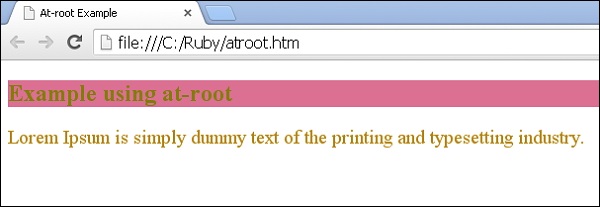
- Sass - Home
- Sass - Overview
- Sass - Installation
- Sass - Syntax
- Using Sass
- Sass - CSS Extensions
- Sass - Comments
- Sass - Script
- Sass - @-Rules and Directives
- Control Directives & Expressions
- Sass - Mixin Directives
- Sass - Function Directives
- Sass - Output Style
- Extending Sass
Sass - At-root Directives
Description
The @at-root directive is a collection of nested rules which is able to make the style block at root of the document.
@at-root (without: ...) and @at-root (with: ...)
@at-root selector excludes the selector by default. By using @at-root, we can move the style outside of nested directive.
For instance, create one SASS file with the following code −
@media print {
.style {
height: 8px;
@at-root (without: media) {
color: #808000;;
}
}
}
The above code will be compiled to the CSS file as shown below −
@media print {
.style {
height: 8px;
}
}
.style {
color: #808000;
}
Example
The following example demonstrates the use of @at-root in the SCSS file −
atroot.htm
<!doctype html>
<head>
<title>At-root Example</title>
<link rel = "stylesheet" href = "atroot.css" type = "text/css" />
</head>
<body class = "container">
<h2>Example using at-root</h2>
<p class = "style">Lorem Ipsum is simply dummy text of the printing and typesetting industry.</p>
</body>
</html>
Next, create file atroot.scss.
atroot.scss
h2 {
color: #808000;
background-color: #DB7093;
@at-root {
.style{
font-size: 20px;
font-style: bold;
color: #B8860B;
}
}
}
You can tell SASS to watch the file and update the CSS whenever SASS file changes, by using the following command −
sass --watch C:\ruby\lib\sass\atroot.scss:atroot.css
Next, execute the above command; it will create the atroot.css file automatically with the following code −
atroot.css
h2 {
color: #808000;
background-color: #DB7093;
}
.style {
font-size: 20px;
font-style: bold;
color: #B8860B;
}
Output
Let us carry out the following steps to see how the above given code works −
Save the above given html code in atroot.html file.
Open this HTML file in a browser, an output is displayed as shown below.
